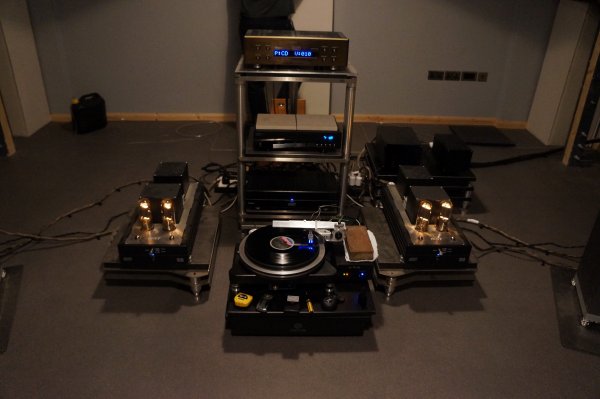Hello All,
I would like to post an update on Marc's system after my visit yesterday to his lovely chapel in rural England.
I believe Marc has made some upgrades including new tubes, further Stacore platforms and new power supplies to his TT. I will let Marc bore you

with the details should he wish to contribute. Try stopping him!
I also know he changed his seating position and reduced his bass output after taking onboard various WBF members decision to remove subs or similar from their systems.
After settling back into his enormous loft space and adjusting to the acoustics, the room 'sounds' different to my room, Marc was in total control of music selection as he wanted to present his system in the best possible light.
Up first were three tracks from Michael Hedges. Immediately I heard a very wide guitar, in fact too wide, the guitar almost appeared to be split in two between left and right speaker. Was this the new near field position Marc likes?
Second track was the same split presentation. I was beginning to wonder what is happening and finally the third track revealed a locked in image just off centre with little L/R action, almost mono.
This all perplexed me and I started to think it was the near field listening position that was responsible for this disparity.
Marc then played some Steve Morse tracks. Different presentation but once again I heard weird anomalies within the soundstage. The central image was locked in but distinct in tonal quality from the L/R sounds that were forward in the mix. Was this just a poor mix?
Another track from Steve Morse and a more distant seating position gave greater homogenisation of the soundstage ie. the band were now together but still I wasn't happy with the now more distant presentation even though we lifted the volume 1 click to compensate for the farther field listening. (We didn't have any measurement equipment to accurately check volume levels).
Much deliberation on my part ensued and Marc was dumbfounded? He thought his system was sounding the best it had been for a long time.
We had a little break and chatting whilst walking around the room I noticed that his once damped loft space now had the front area more live sounding, after removing all his GIK panels, and the back area even more damped than previously heard. So he effectively had this steep slope of dampening from back to front.
I suggested we add the panels back into the front area, 1st reflection points, centre front 2 stacked high and doubled up the front corner bass traps. To be brief, this transformed, IMO, the entire soundstage. There was now a much more holographic soundstage with wonderful spread between the speakers and extending further back from the plane of the speakers without losing the even tonal quality. The difference between the two seat positions was also much less noticeable and came down to personal preference.
I was now happy with the sound we achieved so far.
Marc then played my bass torture track, James Blake - Overgrown. Oh shit! Disaster!
Overblown, uncontrolled, slow, plodding, you name it, it was awful.
Marc had reduced the bass on his subs, we checked with a test disc and there was nothing much useful below 50Hz. Was this just the bass above 50Hz we were hearing and so oddly flabby? I strongly suspect the bass driver just can not keep up with the much more responsive full range drivers but it could be bass settings too. Something Marc will once again have to play with.
At the end of the day we played Previn's Panets from Vinyl and finally I was able to hear a huge soundstage from farthermost back L/R and spread between the speakers. In fact this is the first time I've ever heard Zu speakers disappear. I think we now have an optimum toe in, slightly further back seating position and adequate absorption in the room with only minor adjustments to make to the bass settings. It may not be perfect but probably the best we'll get from the Zu.
One last note, Marc tried several brands of speaker feet and settled on a newcomer, Revopods which I'll ask Marc to comment on. They look the business and are much smaller than expected. Something to consider for my tube amps perhaps.
Make of this what you will but I can't identify one single component at fault, however, it would be very interesting to substitute the Zus to resolve some of the issues faced.
Compared to my system (Duos/SET/Streamer/Dac) Marc's has greater soundstage width and depth, but less resolution and less dynamics. Perfect for him, perfect for me.
Blue58

















